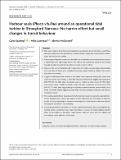Files in this item
Harbour seals (Phoca vitulina) around an operational tidal turbine in Strangford Narrows : no barrier effect but small changes in transit behaviour
Item metadata
| dc.contributor.author | Sparling, Carol Elizabeth | |
| dc.contributor.author | Lonergan, Mike | |
| dc.contributor.author | McConnell, Bernie J | |
| dc.date.accessioned | 2017-08-18T23:32:11Z | |
| dc.date.available | 2017-08-18T23:32:11Z | |
| dc.date.issued | 2018-02 | |
| dc.identifier | 250176780 | |
| dc.identifier | 1b932855-5300-4406-8f63-911cca883c86 | |
| dc.identifier | 85042111359 | |
| dc.identifier | 000425121900020 | |
| dc.identifier.citation | Sparling , C E , Lonergan , M & McConnell , B J 2018 , ' Harbour seals ( Phoca vitulina ) around an operational tidal turbine in Strangford Narrows : no barrier effect but small changes in transit behaviour ' , Aquatic Conservation: Marine and Freshwater Ecosystems , vol. 28 , no. 1 , pp. 194-204 . https://doi.org/10.1002/aqc.2790 | en |
| dc.identifier.issn | 1052-7613 | |
| dc.identifier.other | ORCID: /0000-0001-7575-5270/work/56052233 | |
| dc.identifier.other | ORCID: /0000-0001-7658-5111/work/89178119 | |
| dc.identifier.uri | https://hdl.handle.net/10023/11512 | |
| dc.description | Funding: NERC Marine Renewable Energy Knowledge Exchange Programme (Contract 4060038637) and NERC grant SMRU1001. | en |
| dc.description.abstract | 1. Data were obtained from 32 electronic tags that were glued to the fur of harbour seals (Phoca vitulina) in and around Strangford Lough, Northern Ireland, during the environmental monitoring of the SeaGen tidal turbine. 2. This study provides the first detailed information on the behaviour of marine mammals close to a commercial-scale tidal energy device. The turbine did not prevent transit of the animals through the channel and therefore did not result in a ‘barrier’ effect. 3. However, the animals' behaviour did change when the turbine was operating, demonstrating the importance of allowing for behavioural responses when estimating collision risks associated with tidal turbines. 4. Tagged animals passed the location of the device more frequently during slack water than when the current was running. In 2010 the frequency of transits by tagged seals reduced by 20% (95% CI: 10–50%) when the turbine was on, relative to when it was off. This effect was stronger when considering daylight hours only with a reduction of transit rate of 57% (95% CI: 25–64%). Seals tagged during the operational period transited approximately 250 m either side of the turbine suggesting some degree of local avoidance compared with the pre-installation results. 5. The results presented here have implications for monitoring and managing the potential interactions between tidal turbines and marine wildlife. Principally that the design of telemetry studies for measuring change in response to developments should seek to understand and take into account variability in seal behaviour. 6. This study only looked at the effects of a single turbine rather than an array, and mitigation limited the ability to determine close range interactions. However, the study indicates that the effect of the turbine on Strangford Lough harbour seals was minor and that collision risk was reduced by the behaviour of the seals. | |
| dc.format.extent | 506393 | |
| dc.language.iso | eng | |
| dc.relation.ispartof | Aquatic Conservation: Marine and Freshwater Ecosystems | en |
| dc.subject | Behaviour | en |
| dc.subject | Coastal | en |
| dc.subject | Environmental impact assessment | en |
| dc.subject | Mammals | en |
| dc.subject | Renewable energy | en |
| dc.subject | Tracking | en |
| dc.subject | GC Oceanography | en |
| dc.subject | QH301 Biology | en |
| dc.subject | SH Aquaculture. Fisheries. Angling | en |
| dc.subject | NDAS | en |
| dc.subject | SDG 7 - Affordable and Clean Energy | en |
| dc.subject | SDG 14 - Life Below Water | en |
| dc.subject.lcc | GC | en |
| dc.subject.lcc | QH301 | en |
| dc.subject.lcc | SH | en |
| dc.title | Harbour seals (Phoca vitulina) around an operational tidal turbine in Strangford Narrows : no barrier effect but small changes in transit behaviour | en |
| dc.type | Journal article | en |
| dc.contributor.sponsor | NERC | en |
| dc.contributor.sponsor | NERC | en |
| dc.contributor.institution | University of St Andrews. School of Biology | en |
| dc.contributor.institution | University of St Andrews. Sea Mammal Research Unit | en |
| dc.contributor.institution | University of St Andrews. Marine Alliance for Science & Technology Scotland | en |
| dc.contributor.institution | University of St Andrews. Scottish Oceans Institute | en |
| dc.identifier.doi | https://doi.org/10.1002/aqc.2790 | |
| dc.description.status | Peer reviewed | en |
| dc.date.embargoedUntil | 2017-08-18 | |
| dc.identifier.grantnumber | NE/R015007/1 | en |
| dc.identifier.grantnumber | Agreement R8-H12-86 | en |
This item appears in the following Collection(s)
Items in the St Andrews Research Repository are protected by copyright, with all rights reserved, unless otherwise indicated.

